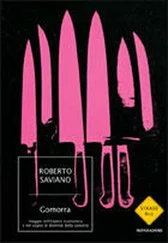Roberto Saviano - Gomorrah - A Personal Journey into the Violent International Empire of Naples’ Organized Crime System
Здесь есть возможность читать онлайн «Roberto Saviano - Gomorrah - A Personal Journey into the Violent International Empire of Naples’ Organized Crime System» весь текст электронной книги совершенно бесплатно (целиком полную версию без сокращений). В некоторых случаях можно слушать аудио, скачать через торрент в формате fb2 и присутствует краткое содержание. Жанр: Старинная литература, на английском языке. Описание произведения, (предисловие) а так же отзывы посетителей доступны на портале библиотеки ЛибКат.
- Название:Gomorrah: A Personal Journey into the Violent International Empire of Naples’ Organized Crime System
- Автор:
- Жанр:
- Год:неизвестен
- ISBN:нет данных
- Рейтинг книги:5 / 5. Голосов: 1
-
Избранное:Добавить в избранное
- Отзывы:
-
Ваша оценка:
- 100
- 1
- 2
- 3
- 4
- 5
Gomorrah: A Personal Journey into the Violent International Empire of Naples’ Organized Crime System: краткое содержание, описание и аннотация
Предлагаем к чтению аннотацию, описание, краткое содержание или предисловие (зависит от того, что написал сам автор книги «Gomorrah: A Personal Journey into the Violent International Empire of Naples’ Organized Crime System»). Если вы не нашли необходимую информацию о книге — напишите в комментариях, мы постараемся отыскать её.
Gomorrah: A Personal Journey into the Violent International Empire of Naples’ Organized Crime System — читать онлайн бесплатно полную книгу (весь текст) целиком
Ниже представлен текст книги, разбитый по страницам. Система сохранения места последней прочитанной страницы, позволяет с удобством читать онлайн бесплатно книгу «Gomorrah: A Personal Journey into the Violent International Empire of Naples’ Organized Crime System», без необходимости каждый раз заново искать на чём Вы остановились. Поставьте закладку, и сможете в любой момент перейти на страницу, на которой закончили чтение.
Интервал:
Закладка:
Doubtless unknown to IKEA, the largest IKEA complex in Italy now sits on land controlled by Moccia companies, as will the biggest high-speed train construction site in southern Italy. In October 2005—for the umpteenth time—the municipal government of Afragola was dissolved for Camorra infiltration. The accusations are heavy: a group of Afragola city council members requested the president of a commercial entity to hire more than 250 people with close family ties to the Moccia clan.
Illegal building permits also contributed to the decision to dissolve the municipality. There are megastructures on boss-owned properties and talk of a hospital being constructed on land the clan acquired just as the city council was debating the issue. Land bought for very little and then, once the location for the new hospital was announced, sold for an astronomical amount. For 600 percent more than the original price. A profit only the Moccia women were able to achieve.
Women such as Anna Vollaro worked in the trenches to defend clan assets and properties. Niece of the Portici clan boss Luigi Vollaro, Anna was twenty-nine when the police showed up to seize yet another family business, this time a pizzeria. She doused herself with gasoline and lit a match, and to make sure no one could put out the flames, she ran around wildly, finally hitting a wall. The plaster turned black, as when an outlet short-circuits. Anna Vollaro burned herself alive to protest the seizure of an illicitly acquired asset that she considered the product of the normal course of business.
One tends to think that in the criminal world military success leads to a position in business. But that’s not always the case. Take the feud in Quindici, a town in the province of Avellino, which has endured the constant, suffocating presence of the Cava and Graziano clans for years. In the 1970s the Cavas were a subset of the Grazianos. But the two families have been at war forever. When the 1980 earthquake destroyed the Lauro Valley, the 100 billion lire of reconstruction funds that poured in gave rise to a middle class of Camorra businessmen. The money allowed both families to establish small construction empires, both run by the women. The battle was sparked by disagreements over contracts and kickbacks from the earthquake reconstruction funds. What unfolded in Quindici was different from in the rest of Campania, however: not simply a factional conflict, but a family feud resulting in around forty savage murders that sowed mourning among the rival groups and created an undying hatred that has contaminated generations of family leaders like the plague. The town watches helplessly as the two factions continue to slaughter each other. One day when the mayor, who had been elected through Graziano backing, was in his office, a group of Cava commandos knocked at his door. They didn’t open fire right away, giving him time to climb out the window onto the roof, and escape along the tops of the houses.
The Graziano clan has produced five mayors, two of whom were murdered; the other three were removed by the Italian president for having ties to the Camorra. But there was a moment when it seemed things could change. When a young pharmacist, Olga Santaniello, was elected mayor. Only a tough woman could take on the Cava and Graziano women. She did everything she could to wash away the filth of clan power, but she didn’t succeed. On May 5, 1998, a devastating flood inundated the entire Lauro Valley, turning houses into sponges that soaked up water and mud, the earth into slimy pools, and the streets into useless canals. Olga Santaniello drowned. The mud that suffocated her was doubly rewarding for the clans: the flood meant more aid money, and the power of the clans increased. Antonio Siniscalchi was elected mayor and reelected unanimously four years later. After his first electoral victory, Siniscalchi, his advisers, and his most vocal supporters marched from the polling station to the Brosagro neighborhood, passing in front of the home of Arturo Graziano, who was called guaglione or boy. The salutations were not directed at him, however, but at the Graziano women. Lined up in order of age, they stood on the balcony as the new mayor paid them homage now that death had definitively eliminated Olga Santaniello. In June 2002, Antonio Siniscalchi was arrested in a blitz carried out by the Naples DDA. According to the Neapolitan anti-Mafia prosecutor’s office, he used the first round of reconstruction funds to redo the street and fencing surrounding the Graziano family’s bunker-villa.
The villas scattered around Quindici, the secret hideaways, paved roads, and streetlamps were paid for by the town, public works that helped the Grazianos and made them immune to attacks and ambushes. The representatives of the two families lived barricaded behind insurmountable fences and under twenty-four-hour closed-circuit surveillance.
Clan boss Biagio Cava was arrested at the Nice airport as he was getting on a plane to New York. With Biagio behind bars, all the power passed to his daughter and wife. Only the women showed their faces in the town; not only were they the behind-the-scenes administrators and brains of the operation, but they also became the official symbol of the families, the faces and eyes of power. When the rival families met on the street, they would exchange ferocious looks and intense stares—an absurd game, a test of who would drop their gaze first. Tension in the town was high. The Cava women realized that the time had come to take up arms, to go from being businesswomen to killers. They trained in apartment entranceways, the music turned up loud to cover the sound of pistols being unloaded into bags of walnuts that had been gathered on their country estates. During the 2002 local elections, Maria Scibelli, Michelina Cava, and her daughters, sixteen-year-old Clarissa and nineteen-year-old Felicetta, started going around armed. On Via Cassese the Cava women’s car—an Audi 80—encountered the Graziano women’s car, with twenty-and twenty-one-year-old Stefania and Chiara Graziano aboard. The Cavas started to shoot, but the Grazianos braked hard, as if they’d been expecting them. They swerved, accelerated, reversed, and escaped. Bullets shattered windows and pierced the body of the car, but didn’t hit flesh. The two girls returned to their villa in hysterics. Their mother, Anna Scibelli, and clan boss Luigi Salvatore Graziano, the seventy-year-old family patriarch, decided to avenge the attack. They took off together in his Alfa, followed by a bulletproof car carrying four people with submachine guns and rifles. They intercepted the Cava Audi, slamming into it repeatedly as the backup car blocked first the side and then the front exit, preventing any chance of getaway. The Cava women, fearful of being stopped by the carabinieri after their unsuccessful shoot-out, had relieved themselves of their weapons, so when they found a car blocking their path, they swerved, flung open the doors, and tried to escape on foot. The Grazianos got out and opened fire, showering the Cavas’ legs, heads, shoulders, chests, cheeks, and eyes with lead. In a matter of seconds they were down, shoes flying and feet in the air. It seems that the Grazianos treated their bodies mercilessly, without realizing that one of them was still alive. In fact, Felicetta Cava survived. A small bottle of acid was found in one of the Cava women’s purses. Perhaps in addition to shooting, they intended to disfigure their enemies by throwing acid on their faces.
Women are better able to confront crime as if it were only momentary, or someone’s opinion, or a step one takes before quickly moving on. Clan women demonstrate this very clearly. They feel offended and vilified when they are called Camorristi or criminals, as if “criminal” were merely a judgment of an action, not an objective way of behaving. In fact, contrary to the men, so far not one female Camorra boss has ever repented. Not one.
Читать дальшеИнтервал:
Закладка:
Похожие книги на «Gomorrah: A Personal Journey into the Violent International Empire of Naples’ Organized Crime System»
Представляем Вашему вниманию похожие книги на «Gomorrah: A Personal Journey into the Violent International Empire of Naples’ Organized Crime System» списком для выбора. Мы отобрали схожую по названию и смыслу литературу в надежде предоставить читателям больше вариантов отыскать новые, интересные, ещё непрочитанные произведения.
Обсуждение, отзывы о книге «Gomorrah: A Personal Journey into the Violent International Empire of Naples’ Organized Crime System» и просто собственные мнения читателей. Оставьте ваши комментарии, напишите, что Вы думаете о произведении, его смысле или главных героях. Укажите что конкретно понравилось, а что нет, и почему Вы так считаете.












